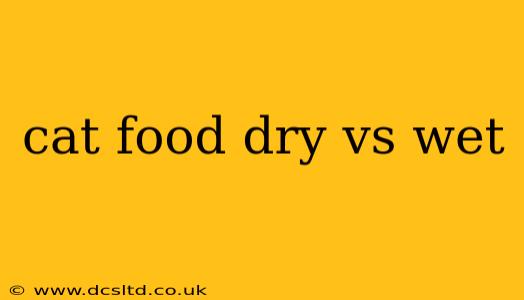Choosing the right food for your feline companion is crucial for their health and happiness. The age-old debate: dry versus wet cat food, often leaves cat owners scratching their heads. This comprehensive guide will delve into the pros and cons of each, helping you make an informed decision for your furry friend.
What's the Difference Between Dry and Wet Cat Food?
The primary difference lies in moisture content. Wet cat food, also known as canned cat food, typically contains 70-80% moisture, while dry cat food (kibble) contains only around 10%. This fundamental difference impacts various aspects of your cat's health and your feeding routine.
Pros and Cons of Dry Cat Food
Pros:
- Convenience: Dry food is easy to store, doesn't require refrigeration, and is generally less expensive per calorie than wet food.
- Dental Health: The texture of kibble can help scrape plaque and tartar from your cat's teeth, contributing to better oral hygiene.
- Weight Management: Because dry food is less calorie-dense than wet food (per unit volume), it can be helpful for managing weight in overweight cats. Portion control is key, however.
- Longer Shelf Life: Dry food has a longer shelf life than wet food once opened.
Cons:
- Lower Moisture Content: The low moisture content can contribute to dehydration, particularly in cats prone to urinary tract issues.
- Less Palatable: Some cats find dry food less appealing than wet food, especially finicky eaters.
- Potential for Higher Carbohydrate Content: Some dry food formulas contain higher levels of carbohydrates compared to wet food.
Pros and Cons of Wet Cat Food
Pros:
- Higher Moisture Content: The high moisture content helps cats stay hydrated, which is especially beneficial for urinary tract health.
- More Palatable: Many cats find the taste and texture of wet food more appealing.
- Higher Protein Content (Often): Often, wet food boasts a higher percentage of protein compared to dry food, contributing to a cat’s overall health.
- Easier Digestion (for some): The softer texture of wet food may be easier to digest for some cats, especially senior cats or those with digestive sensitivities.
Cons:
- Cost: Wet food is generally more expensive per calorie than dry food.
- Storage: Wet food requires refrigeration after opening and has a shorter shelf life.
- Messiness: Wet food can be messier than dry food.
Which Type of Food is Better for My Cat?
There's no single "best" type of cat food. The ideal choice depends on several factors:
- Your cat's preferences: Does your cat prefer the taste and texture of wet or dry food?
- Your cat's health: Cats with urinary tract issues often benefit from higher moisture content in their diet. Senior cats may also find wet food easier to digest.
- Your budget: Wet food is generally more expensive.
- Your lifestyle: Dry food is more convenient for busy owners.
Ideally, a balanced approach, incorporating both wet and dry food, may be the optimal solution for many cats, providing the benefits of both. Always consult with your veterinarian to determine the best diet for your cat's individual needs and health status.
What are the nutritional differences between wet and dry cat food?
The main nutritional difference is the moisture content, as previously discussed. However, the protein, fat, and carbohydrate levels can also vary significantly between brands and formulations. It's crucial to check the ingredient list and nutritional information on the packaging and compare different products. Look for high-quality protein sources as the primary ingredient.
Can I mix wet and dry cat food?
Yes, absolutely! Many cat owners successfully mix wet and dry food to provide a balance of taste, texture, and hydration. You can offer a combination in separate bowls or mix them together, depending on your cat's preference. Experiment to find what your cat enjoys most.
Is one type of cat food better for kittens than others?
For kittens, high-quality wet food is often recommended due to the higher moisture content, which is essential for their growing bodies. However, kitten-specific dry kibble can also be a part of a balanced diet. Again, consult your veterinarian for recommendations tailored to your kitten's age and breed.
How much cat food should I feed my cat?
Feeding guidelines are usually printed on the packaging of the cat food. However, these are general guidelines. Your cat's ideal food intake will depend on factors such as age, weight, activity level, and overall health. Consult your veterinarian for personalized recommendations. Always monitor your cat's weight and adjust food portions as needed.
By carefully considering these factors and consulting your veterinarian, you can select the optimal cat food to keep your feline friend happy, healthy, and thriving. Remember that consistent monitoring and veterinary guidance are essential for ensuring your cat receives the best possible nutrition.
